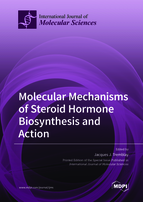Molecular Mechanisms of Steroid Hormone Biosynthesis and Action
A special issue of International Journal of Molecular Sciences (ISSN 1422-0067). This special issue belongs to the section "Biochemistry".
Deadline for manuscript submissions: closed (1 November 2022) | Viewed by 35479
Special Issue Editor
2. Centre for Research in Reproduction, Development and Intergenerational Health, Department of Obstetrics, Gynecology and Reproduction, Faculty of Medicine, Université Laval, Québec, QC G1V 0A6, Canada
Interests: leydig cells; steroidogenesis; gene expression; hormone action; male sex differentiation; transcription factors; endocrine disruptors
Special Issue Information
Dear Colleagues,
Steroids are essential hormones that are needed to regulate biological processes across the lifespan. Steroid hormone production and action must be tightly controlled; otherwise, there can be detrimental effects on physiological function leading to disease.
The biosynthesis of steroids and their actions in target tissues and cells are complex; however, coordinated processes that rely on a series of diverse cellular and molecular events, ranging from proper steroidogenic cell differentiation and gene expression to hormone transport, hormone processing, and hormone action via interaction with specific receptors. The regulation of these events requires the concerted action of various hormones, growth factors, transcription factors, and other signaling and regulatory molecules that are needed to ensure adequate genomic, cellular, and/or physiological responses. Many of these processes are also targets for endocrine disruption.
This Special Issue on the “Molecular mechanisms of steroid hormone biosynthesis and action” welcomes original research and review articles in this field. Potential topics of interest may include, but are not limited, to the following:
- Mechanisms of steroidogenic cell differentiation.
- Steroid hormone biosynthesis, including substrate availability, mechanism of steroidogenic enzyme action via the classical and backdoor pathways.
- Molecular and cellular regulation of steroidogenesis, including steroidogenic cell response to hormone stimulation, signaling pathways, kinases, transcription factors, and gene expression.
- Mechanisms of steroid hormone action on target cells, including genomic and non-genomic pathways.
- Molecular mechanisms of endocrine disruptor action on steroidogenic cells.
- New tools and approaches to study steroidogenesis and steroid hormone action.
This Special Issue aims to gather experts at the cutting edge of their fields to disseminate their latest work to a broad range of readership.
Dr. Jacques J. Tremblay
Guest Editor
Manuscript Submission Information
Manuscripts should be submitted online at www.mdpi.com by registering and logging in to this website. Once you are registered, click here to go to the submission form. Manuscripts can be submitted until the deadline. All submissions that pass pre-check are peer-reviewed. Accepted papers will be published continuously in the journal (as soon as accepted) and will be listed together on the special issue website. Research articles, review articles as well as short communications are invited. For planned papers, a title and short abstract (about 100 words) can be sent to the Editorial Office for announcement on this website.
Submitted manuscripts should not have been published previously, nor be under consideration for publication elsewhere (except conference proceedings papers). All manuscripts are thoroughly refereed through a single-blind peer-review process. A guide for authors and other relevant information for submission of manuscripts is available on the Instructions for Authors page. International Journal of Molecular Sciences is an international peer-reviewed open access semimonthly journal published by MDPI.
Please visit the Instructions for Authors page before submitting a manuscript. There is an Article Processing Charge (APC) for publication in this open access journal. For details about the APC please see here. Submitted papers should be well formatted and use good English. Authors may use MDPI's English editing service prior to publication or during author revisions.
Keywords
- Leydig cells
- adrenal cortex
- ovary
- placenta
- steroidogenesis
- hormone action
- steroid hormone receptors
- endocrine disruptors
- transcription factors
- HPG and HPA axes
- non-classical steroidogenic tissues







